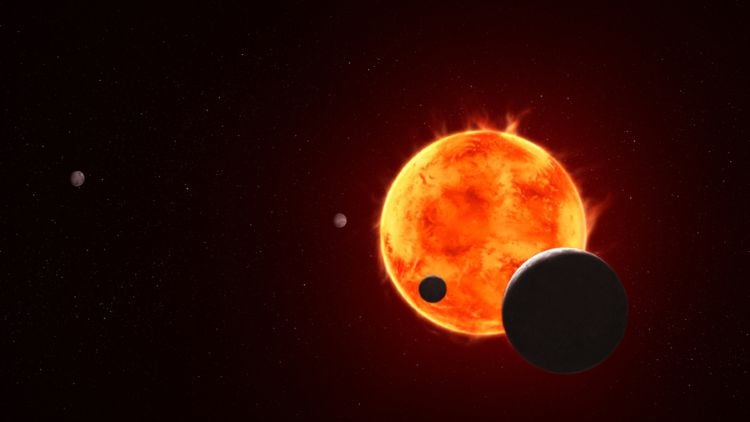Science
Scientists Explore Airborne Microbes for Life Detection on Exoplanets

Research scientists are investigating the potential for identifying microbial biosignatures in the atmospheres of exoplanets. A recent manuscript presents findings that could enhance methods for discovering life beyond Earth, focusing particularly on airborne microbes that may exist in the clouds of distant planets. This groundbreaking study aims to create new pathways for recognizing life, whether in familiar forms or entirely unknown variants.
To conduct their research, the team executed a series of laboratory experiments using seven microbial strains sourced from Earth’s atmosphere. The strains included notable species such as Modestobacter versicolor, Roseomonas vinacea, Micrococcus luteus, Massilia niabensis, and Noviherbaspirillum soli, alongside Curtobacterium aetherium and Curtobacterium oceanosedimentum. Employing spectroscopy, they analyzed the reflected light, or spectral features, from these samples to determine if these signatures could indicate the presence of life in exoplanet atmospheres.
The results revealed that each microbial sample displayed unique biosignatures, which could be detected within the clouds and atmospheres of exoplanets. The researchers concluded that their findings represent a significant advancement in the search for extraterrestrial life. They stated, “Here, we present an additional path for searching for life on Earth-like exoplanets: the search for biopigments as signs of life in clouds.” This research provides a new spectral reference to assist in the detection and interpretation of potential biosignatures during future exploratory missions.
Motivations for this study can be traced back to earlier works, including a 1976 study by Dr. Carl Sagan and Dr. Ed Salpeter, who proposed the existence of life forms in the clouds of Jupiter. Their research introduced concepts such as “Sinkers,” “Floaters,” “Hunters,” and “Scavengers,” which were theorized to inhabit specific ecological niches within Jupiter’s atmosphere.
In addition to these historical insights, the study aligns with the goals of the upcoming Habitable Worlds Observatory (HWO), a planned space telescope set for launch in the 2040s. The HWO aims to utilize spectroscopy to analyze 25 habitable exoplanets for biosignatures, which may include the microbial signatures identified in this study. Besides exoplanets, HWO will also investigate galaxy evolution, star formation, and other celestial phenomena.
The James Webb Space Telescope (JWST) has already demonstrated the capacity of spectroscopy to explore exoplanet atmospheres. For instance, JWST has successfully detected water, carbon dioxide, and carbon monoxide in the atmosphere of WASP-39 b, located approximately 700 light-years from Earth. Meanwhile, the atmosphere of WASP-17 b, situated about 1,324 light-years away, was found to contain quartz particles at high altitudes.
Recent studies by JWST, published in The Astrophysical Journal Letters, focused on the atmosphere of TRAPPIST-1 e, an Earth-sized exoplanet within its star’s habitable zone. While these investigations have not yet produced conclusive evidence of an atmosphere, they underscore the need for ongoing research in this field. The TRAPPIST-1 system, located around 41 light-years from Earth, contains seven known Earth-sized planets, with three residing in the habitable zone. It is hypothesized that all seven planets are tidally locked to their star, similar to how Earth’s Moon is locked to our planet.
As scientists continue their quest to uncover the mysteries of life in the cosmos, the insights gained from studying airborne microbes could prove invaluable. The evolving landscape of exoplanet research promises exciting developments for the future. Researchers remain dedicated to advancing our understanding of extraterrestrial life, emphasizing the importance of curiosity and exploration.
-

 Business2 weeks ago
Business2 weeks agoIconic Sand Dollar Social Club Listed for $3 Million in Folly Beach
-

 Politics2 weeks ago
Politics2 weeks agoAfghan Refugee Detained by ICE After Asylum Hearing in New York
-

 Health2 weeks ago
Health2 weeks agoPeptilogics Secures $78 Million to Combat Prosthetic Joint Infections
-

 Science2 weeks ago
Science2 weeks agoResearchers Achieve Fastest Genome Sequencing in Under Four Hours
-

 Lifestyle2 weeks ago
Lifestyle2 weeks agoJump for Good: San Clemente Pier Fundraiser Allows Legal Leaps
-

 Health2 weeks ago
Health2 weeks agoResearcher Uncovers Zika Virus Pathway to Placenta Using Nanotubes
-

 World2 weeks ago
World2 weeks agoUS Passport Ranks Drop Out of Top 10 for First Time Ever
-

 Business2 weeks ago
Business2 weeks agoSan Jose High-Rise Faces Foreclosure Over $182.5 Million Loan
-

 Entertainment2 weeks ago
Entertainment2 weeks agoJennifer Lopez Addresses A-Rod Split in Candid Interview
-

 Top Stories1 week ago
Top Stories1 week agoChicago Symphony Orchestra Dazzles with Berlioz Under Mäkelä
-

 World2 weeks ago
World2 weeks agoRegional Pilots’ Salaries Surge to Six Figures in 2025
-

 Science2 weeks ago
Science2 weeks agoMars Observed: Detailed Imaging Reveals Dust Avalanche Dynamics







